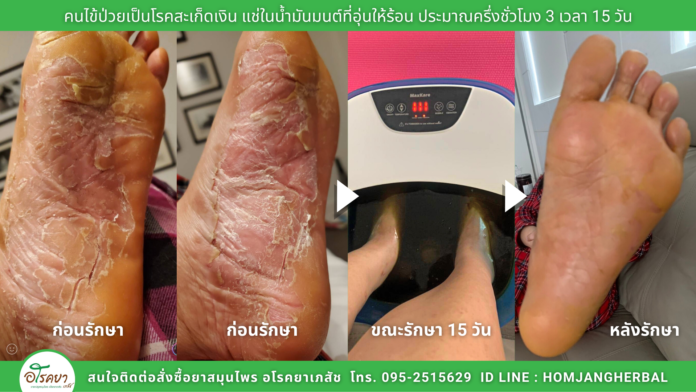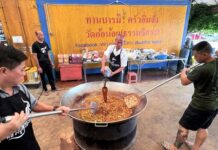เรามาช่วยกันวิสัชนากรรมทั้ง ๑๒ อาการ ให้แจ่มชัดกันดูซักหน่อย (ตอนที่ ๒)
๑๗ มีนาคม ๒๕๖๕
คราวที่แล้วได้หยิบยกเอากรรม ๑๒ มาวิสัชนาแก่ผู้สงสัยไปในระดับหนึ่งไปแล้ว
แต่ดู ดู เหมือนผู้รับรู้รับฟัง ยังจะไม่แจ่มชัดถึงรากเหง้าของกรรมทั้งปวง
วันนี้จึงขอนำกรรมทั้ง ๑๒ อาการ มาอธิบายขยายความให้ท่านทั้งหลายได้เข้าใจ ให้แจ่มชัดมากยิ่งขึ้น หรือไม่ บางคนมีสติปัญญากล้าแข็ง อาจรู้สึกสว่าง กระจ่างแจ้งขึ้นมาบ้างก็เป็นได้
*********************************************
วันนี้ขอวิสัชนาถึง อุปัตถัมภกกรรม หมายถึง กรรมที่คอยอุ้มชู เลี้ยงดู ต่อกรรมทั้งปวง ซึ่งมีทั้งกรรมที่เป็นฝ่ายกุศล และกรรมที่เป็นฝ่ายอกุศล หรืออัพยากตธรรม
อุปัตถัมภกกรรม มีหน้าที่ที่จะเข้าไปแทรกแซง อุ้มชู สนับสนุนให้กรรมนั้นๆ เจริญขึ้น แข็งแรงขึ้น สำเร็จประโยชน์มากขึ้น
ตัวอย่างเช่น โจรไปวิ่งราวสร้อยคอทองคำเขามาจากตลาด ขณะนั้น ฉันกำลังบิณฑบาตรอยู่ที่ตลาด อำเภอเลิงนกทา
โจรเด็กนั้นวิ่งหนีผ่านหน้ามา แล้ววิ่งไปซ่อนตัวอยู่ในเข่งใส่เศษขยะใบใหญ่ ที่กองสุ่มๆ กันหลายสิบใบ
พอตำรวจวิ่งตามมา มองไม่เห็นโจรเด็ก ก็ถามฉันว่า ครูบาเห็นโจรวิ่งมาทางนี้ไหม
ฉันจึงหันไปบอกแก่เจ้าหน้าที่ตำรวจว่า ฉันหันมาทางนี้ก็เห็นมีแต่คุณนี่แหละ (นี้คือลักษณะของอุปัตถัมภกกรรม)
ตำรวจจึงวิ่งตามโจรต่อไป
พอตำรวจไปแล้วฉันเดินเข้าไปเคาะเข่งที่เด็กเข้าไปหลบซ่อนอยู่ แล้วถามที่มาที่ไปว่า ทำไมถึงได้ไปวิ่งราวสร้อยทองแม่ค้าเขามา
เด็กจึงร้องไห้พร้อมบอกว่า จะหาเงินไปรักษาแม่ที่นอนป่วยอยู่โรงพยาบาล แล้วไม่มีเงินรักษา พ่อก็ไม่มี มีน้องอีก ๒ คน ที่ต้องเลี้ยงดู
เขารับจ้างเข็นผักอยู่ในตลาด ได้วันละร้อยกว่าบาท ก็ไม่พอใช้
เขาจึงตัดสินใจวิ่งราวกระชากสร้อยแม่ค้าที่เข้ามาเร่ขายของในตลาด
ฉันจึงถามเด็กไปว่า หากมีเงินไปจ่ายค่ารักษาพยาบาลให้แม่ หนูจะนำทองไปคืนแม่ค้าหรือไม่ (นี้คือการทำหน้าที่ของอุปัตถัมภกกรรมที่เข้าไปแทรกแซง)
เด็กตอบทันทีว่า คืนครับ
ผมก็ไม่อยากจะเป็นโจร แต่ไม่รู้จะหาเงินไปรักษาแม่อย่างไร ผมจึงวิ่งราวสร้อยทอง (นี้คือการทำหน้าที่ของอุปัตถัมภกกรรม)
ต่อมา ฉันจึงพาเด็กเข้าไปหาแม่ค้าเจ้าของสร้อยคอทองคำ แล้วให้เด็กกราบขออภัยที่กระทำผิดไปด้วยความจำเป็น
พร้อมทั้งเด็กก็ส่งมอบสายสร้อยคอคืนให้แก่แม่ค้าและได้เล่าเรื่องราวความจำเป็นให้แม่ค้าฟัง พอแม่ค้ารับรู้เรื่อง จึงเกิดความสงสารยกโทษให้ (นี้คือการทำหน้าที่ของอุปัตถัมภกกรรม)
พร้อมทั้งแม่ค้าท่านนั้น จึงถามเด็กว่า แม่เอ็งรักษาตัวอยู่โรงพยาบาลไหน เดียวจะเข้าไปเยี่ยม จะได้จ่ายค่ารักษาพยาบาลให้เรียบร้อย (นี้คือการทำหน้าที่ของอุปัตถัมภกกรรม)
ที่ยกมาทั้งหมดนี้ เป็นเรื่องจริงที่เกิดขึ้นมาร่วม ๔๐ ปีแล้ว
เพื่อจะยกให้ท่านทั้งหลายได้เห็นการเข้าไปแทรกแซงทำหน้าที่ของอุปัตถัมภกรรม
อีกซักตัวอย่างหนึ่ง
คนไข้ป่วยเป็นสะเก็ดเงิน (หมอในประเทศแคนาดาเป็นผู้วินิจฉัย)
ผู้เป็นแม่จึงโทรมาปรึกษา พูดคุยขอวิธีรักษา เพราะหมอจะตัดขาทิ้งด้วยกลัวว่า อาการจะลุกลาม ด้วยเพราะคนป่วยเป็นเบาหวานด้วย
ฉันจึงแนะนำให้คนป่วยกินยาบำรุงเลือด และยาสะเก็ดเงิน พร้อมทั้งแช่เท้าด้วยน้ำอุ่น ๕ นาที ทุกๆ วัน ๓ เวลา ซับแห้ง
แล้วนำเท้าแช่ลงไปในน้ำมันมนต์ที่อุ่นให้ร้อน แช่ประมาณ ครึ่งชั่วโมง ๓ เวลา ทุกวัน (นี่คือการเข้าไปแทรกแซงทำหน้าที่ของอุปัตถัมภกกรรม)
๑๕ วันต่อมา เท้าของผู้ป่วยก็เป็นอย่างที่ท่านเห็น
เหล่านี้ คือ การเข้าไปแทรกแซงทำหน้าที่ของอุปัตถัมภกกรรม
แต่ไม่ว่าจะยังไงอุปัตถัมภกกรรมก็หาได้อุปถัมภ์เฉพาะกรรมดีแต่ฝ่ายเดียวไม่ ยังสามารถเข้าแทรกแซงหน้าที่อุปถัมภ์กรรมชั่วหรือัพยากตธรรมได้อีกด้วย
พุทธะอิสระ
——————————————–
Let us clarify the twelve characteristics of Karma (deeds) (Part 2)
March 17, 2022
I previously somewhat explained the twelve characteristics of Karma.
However, the listeners are not yet clear about the origins of all Karma.
Today, I will elaborate more on the twelve types of Karma. Some people with sharp wisdom may understand them better.
*********************************************
Today, I will explain the Supportive Karma, which means the Karma nourishes all kinds of deeds, including meritorious, evil, or mediocre deeds.
Supportive Karma has duties to interfere, nourish, and support Karma to be stronger and achieve more outcomes.
For example, a thief had snatched a golden necklace while I was going for alms in a market in the Loeng Nok Tha District of Yasothon Province.
The thief, that was still a kid ran past me and hid behind piling tens of garbage baskets.
When a policeman arrived, he could not see the thief and asked me if I had seen the thief passing by.
I turned to the policeman and told him that I saw only him. (This is a feature of the Supportive Karma.)
Then, the policeman ran further to catch the thief.
After the policeman had left, I walked to the thief and hit the basket to signal him.
I asked him why he had snatched the golden necklace.
He cried and told me that he wanted the money for his sick mother at a hospital.
His mother had no money for the treatment. The boy had no father, and he had to look after two younger brothers.
He earned over a hundred Baht per day from his labor at the market, and it was not enough to cover the expenses.
So, he decided to snatch a necklace from a female vendor at the market.
Then, I asked the boy whether he would return the golden necklace if he had had enough money for his mother’s treatment. (This shows how the Supportive Karma interfered with the incident.)
The boy said yes right away.
He said he did not want to be a thief, but he did not know how to find the money.
So, he snatched the golden necklace. (This shows how the Supportive Karma works.)
Then, I took the boy to return the gold necklace, and the body apologized to the vendor. When the female vendor knew about it, she sympathized with him and forgave him. (This shows how the Supportive Karma works.)
Furthermore, the female vendor asked the boy at which hospital the boy’s mother was staying; she would visit and pay for her treatment. (This shows how the Supportive Karma works.)
This incident happened approximately forty years ago.
Here is another example to show you how the Supportive Karma works.
A patient with Psoriasis (diagnosed by a Canadian doctor)
His mother called me to ask for advice because the doctor wanted to amputate a leg to hinder the progression of the disease. The patient also had diabetes.
Therefore, I recommended that the patient take some blood tonic and medicine to treat Psoriasis. I also advised him to soak his feet in warm water for five minutes three times every day and dry them.
I recommended he soak his feet in holy oil for half an hour three times per day.
(This shows how the Supportive Karma interferes.)
Fifteen days later, the patient’s feet became as you have seen from the pictures.
These show how the Supportive Karma interfered.
The Supportive Karma nourishes not only meritorious deeds but also evil and mediocre deeds.
Buddha Isara







